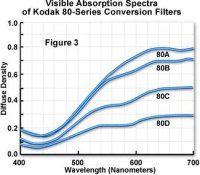Time is the critical factor for me, so I'll load up different enlargers ahead of time with different size
negs I plan to work with. My high-tech color enlargers are generally dedicated to color work, but I
do have a traditional Omega D with a colorhead, which is handy for 4x5, MF, and 35mm VC printing
using the subtractive variable YM route. My 8x10 unit, however, is fitted with a blue-green cold light,
so is ideally controlled using tricolor red and green filtration (split printing). My negs are developed
with enough consistency to where I often just use unmodified light, or just slightly tweak it with
green to put more detail in the highlights, or some blue punch for more contrast in the shadows. With
the Omega colorhead, I often might want a bit more simple contrast using magenta when higher degrees of magnification are needed. The problem with strong blue filters in particular is that you need a very strong light source. Not all enlargers will handle these. But unlike color printing, the needs of VC paper are not nitpicky, and you can get optimized, even identical, results with either additive or subtractive filtration.











